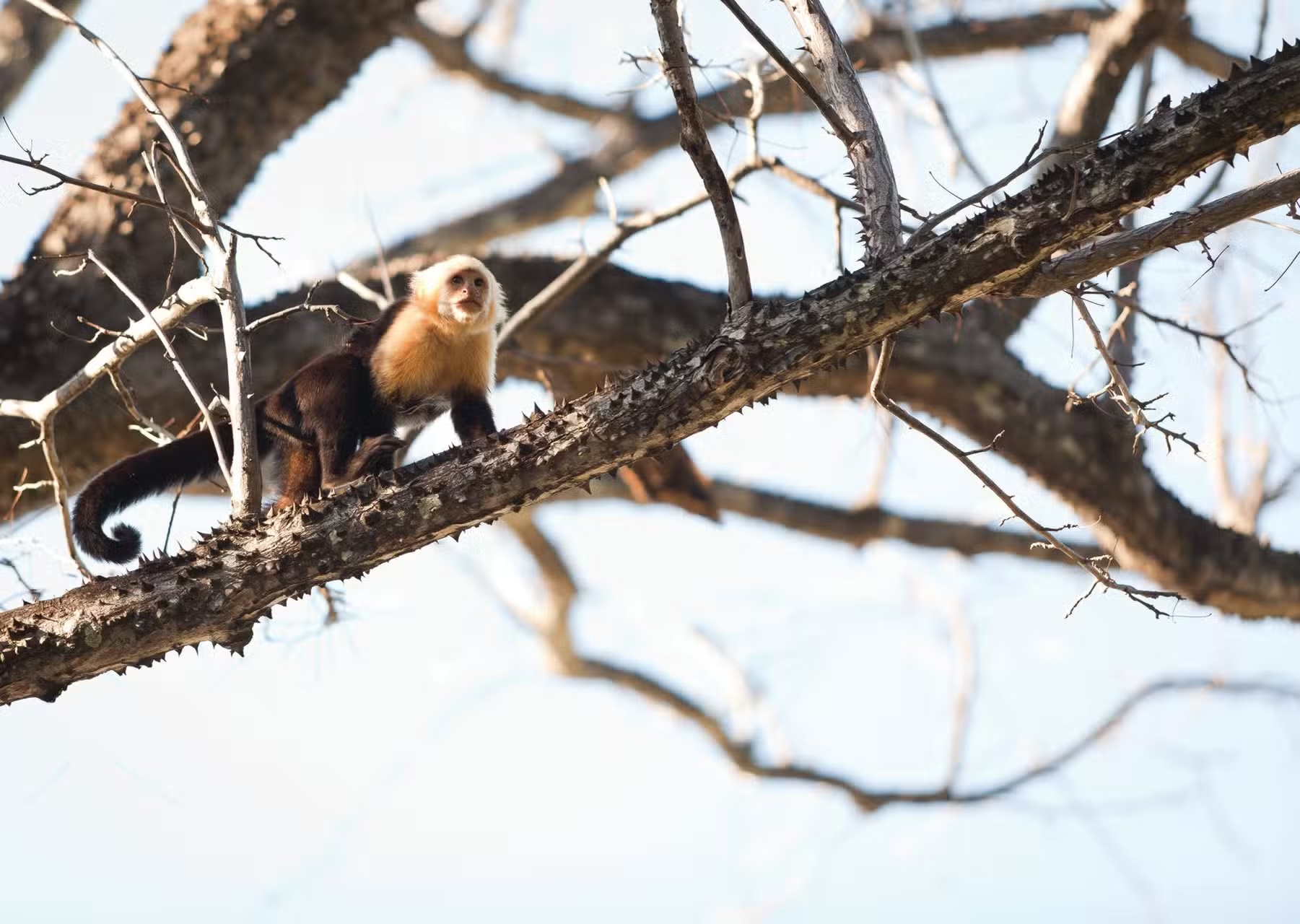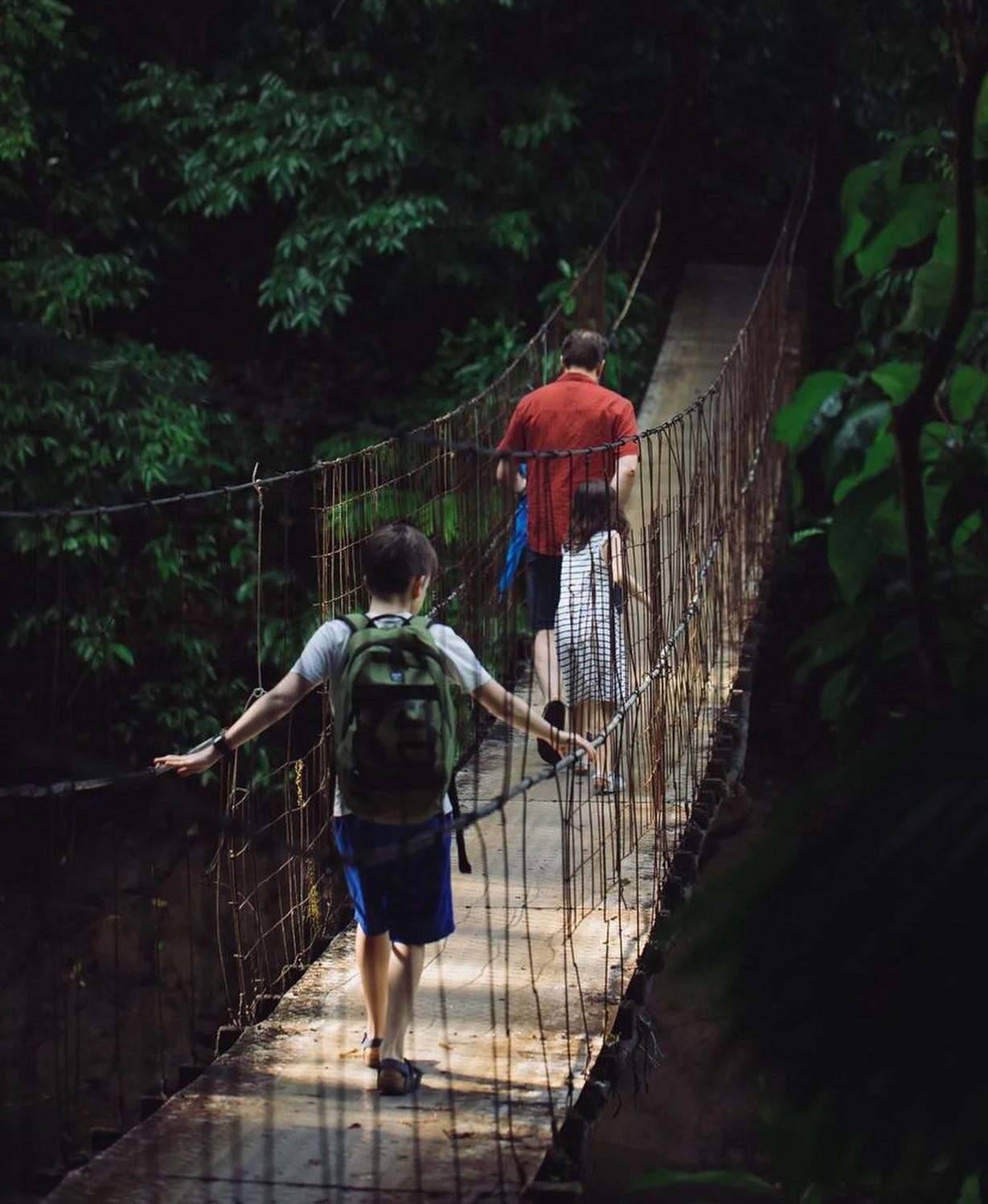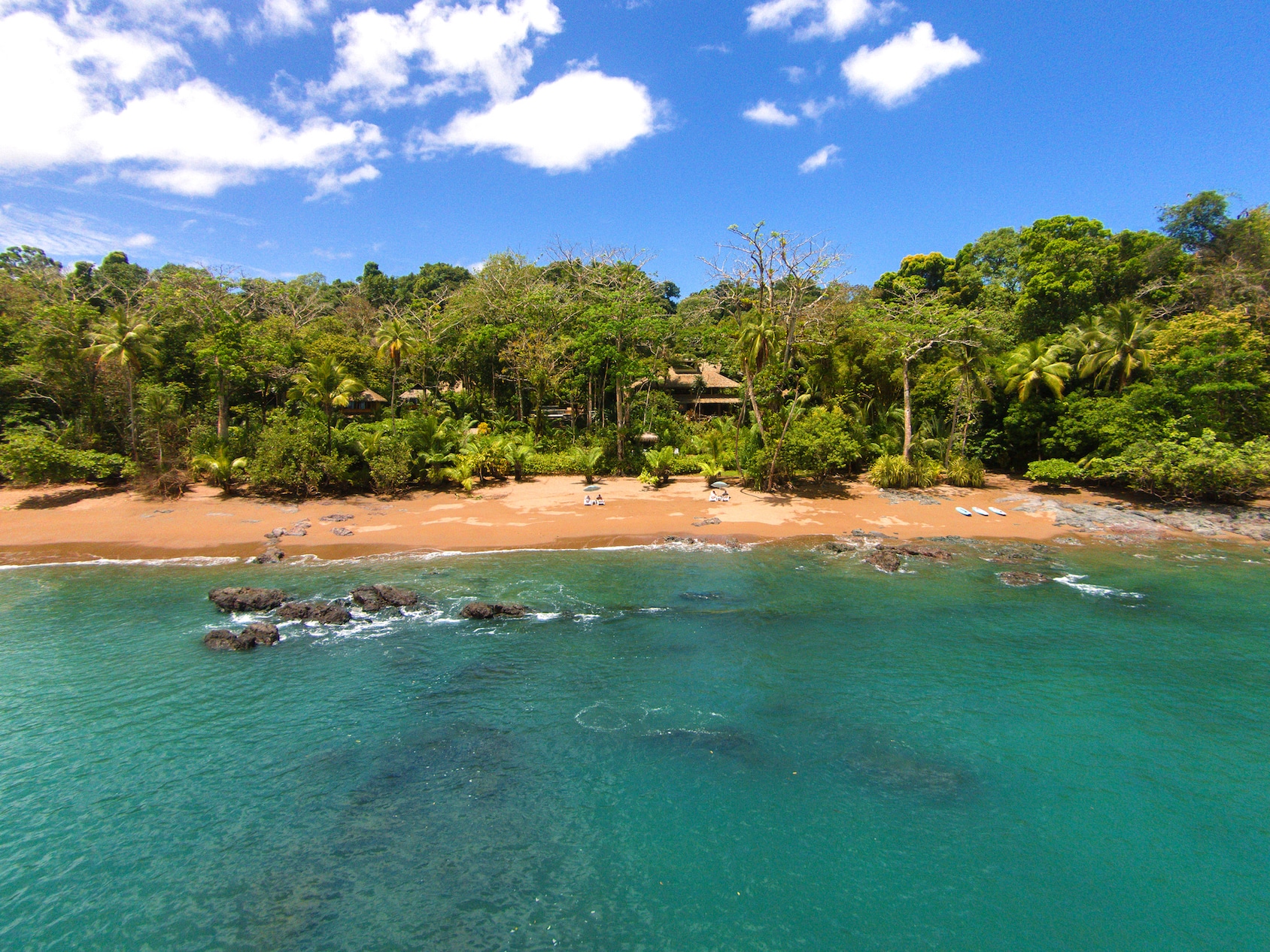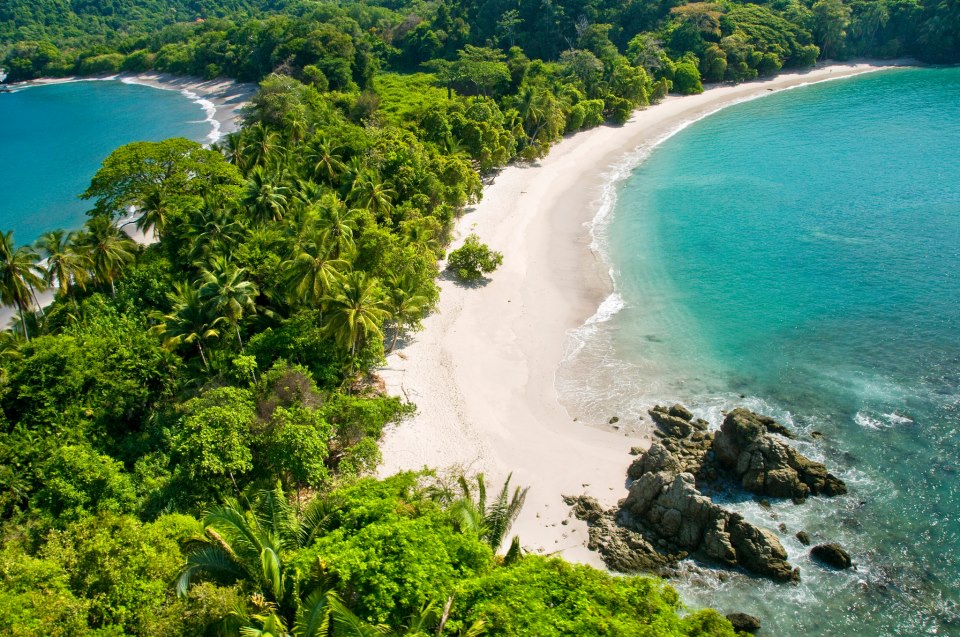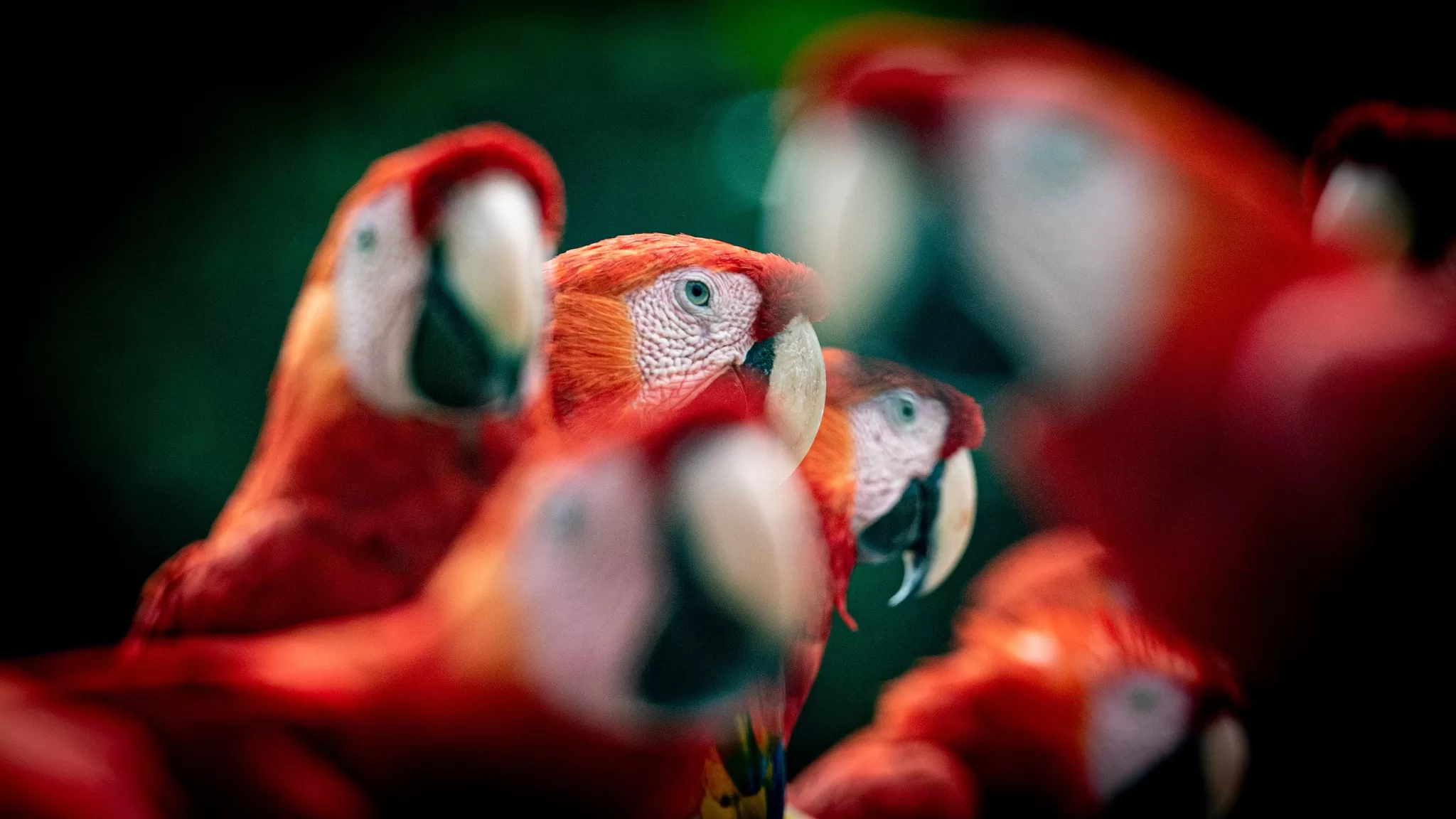
9 Must-See Exotic Costa Rica Animals
Step into the wild heart of Costa Rica, where the rainforests and jungles hum with life. With more than 230 species of mammals and countless other creatures, the forests here are alive with movement and color. It’s not unusual to spot monkeys swinging overhead, a sloth lazily draped across a branch, or a bright red-eyed tree frog peeking out from a leaf. Coatis scamper along the forest floor, while jaguars and tapirs keep a watchful eye from the shadows.

The list below highlights just a few of the incredible animals you might encounter on your Costa Rica adventure.
Sea Turtles

If you’re looking for turtles, Costa Rica is the place. Several species of turtles return every year to the same beaches along both coasts to nest in a grand procession termed arribada. The leatherback sea turtle and hawksbill sea turtle can be found on both the Caribbean Coast and the Pacific Coast. Ostional Beach, Tortuguero National Park, and Playa Grande are all well-known beaches for turtle nesting. Make sure you book your trip during the nesting season, but keep in mind that it an arribada is never guaranteed.
Best Turtle Nesting by Season
- Winter (Dec – Feb): Leatherbacks on both coasts; humpback whales also present (bonus!).
- Spring (Mar – May): Leatherbacks still nesting on the Caribbean; Hawksbills start in the Southern Caribbean.
- Summer (Jun – Aug): Green turtles arrive in Tortuguero; Olive ridleys begin arribadas on the Pacific.
- Fall (Sep – Nov): Peak turtle season! Green turtles, olive ridleys, and hawksbills all nesting.
Expert Tips:
- Arribada events (Olive Ridleys) are most common Sep–Nov at Ostional, where you can see tens of thousands at once.
- Hatchling releases usually follow about 45–60 days after nesting, so you might witness both nesting adults and tiny hatchlings in the same trip.
- Always book a guided night tour, as most turtles nest after dark.
Related Article: Best Costa Rica Sea Turtle Nesting Sites: Where To Go When
Whales

Cost Rica has the longest whale watching season in the world! Humpback whales, pilot whales, blue whales, and Pseudo-Orca whales have all been seen off the Costa Rican coasts. The most popular of these is the humpback whale, which can be seen nearly year-round. From December to early April, the Northern Hemisphere California Humpback Whales come to the Pacific Coast to breed, and from late April to July to November, the Southern Hemisphere Antarctic Humpback Whales come to the Pacific. Whales can be seen along the entire Pacific Coast, but are found in the largest concentrations along the southern coast and the Osa Peninsula.
Whale Species You Might See
- Humpback Whales (most common)
- Pilot Whales
- Blue Whales (rare but possible)
- False Orcas (Pseudorcas)
Best Times to Visit
- December – April: Northern Hemisphere humpbacks arrive from California.
- July – November: Southern Hemisphere humpbacks migrate from Antarctica.
- That means you can see whales almost year-round in Costa Rica!
Expert Tips for Whale Watching
- Base yourself in Uvita or Drake Bay for the best chance to see whales.
- Time your trip with the Whale & Dolphin Festival in Uvita (usually September) for a fun cultural tie-in.
- Book a morning tour — the ocean is calmer, making it easier to spot and photograph whales.
- Choose a small-group tour or private boat for the best experience (less crowding, more flexibility to follow the whales).
- Bring binoculars & a zoom lens — while whales come close, the extra reach helps.
- Respect the animals: good operators will maintain a safe distance and allow the whales to approach you.
Pro Insight: If you dream of seeing whale mothers with calves, plan for September–October in the South Pacific (Marino Ballena & Golfo Dulce). The warm, protected waters are their nursery grounds.
Related Article: Costa Rica Whale Watching Guide: Where To Go When
Scarlet Macaws

The vibrant red color of the scarlet macaw makes it a stand-out among rainforest birds. These beautiful birds are most commonly seen in pairs as they mate for life. Their diet consists mostly of fruit, seeds, and vegetation.
Where to See Scarlet Macaws in Costa Rica
- 1. Carara National Park (Central Pacific Coast)
Carara is one of the best-known strongholds for scarlet macaws. Located just north of Jacó, this park is a transition zone between the dry and wet forests, creating an ideal habitat. Macaws are often spotted flying overhead in pairs or small groups, especially near the Tarcoles River. - 2. Osa Peninsula (Southern Pacific Coast)
The Osa Peninsula is another prime destination. Corcovado National Park and the Golfo Dulce region host large, thriving populations of scarlet macaws. Here, you’ll see them feeding on almond trees or soaring dramatically against the lush green rainforest canopy. - 3. Palo Verde & Tempisque Basin
Less visited but rewarding, the dry forest areas and wetlands of Palo Verde also attract scarlet macaws. This is a more off-the-beaten-path option for travelers looking to escape crowds while still enjoying vibrant birdlife.
Expert Insights
- Best Time of Day: Scarlet macaws are most active in the early morning and late afternoon. Sunrise and sunset are magical times to see pairs flying together, their colors glowing against the sky.
- Look for Almond Trees: Macaws love beach almond trees. If you spot one near your lodge or along a trail, pause and listen for the macaws’ loud squawks—they often gather there to feed.
- Travel in Pairs: These birds are almost always seen in pairs or small family groups since they mate for life. If you see one, look around—you’ll likely spot its partner nearby.
- Conservation Note: Scarlet macaws were once endangered due to habitat loss and the pet trade. Thanks to strict protections and reintroduction programs, their numbers are rebounding. Spotting them in the wild is not only beautiful—it’s a conservation success story in action.
Monkeys

There are four monkey species in Costa Rica: white-faced capuchin, mantled howler, squirrel monkey, and the spider monkey. These guys travel in troops. So if you see one, you’ll probably see the whole gang! Monkeys can be found up and down both coasts, but are much less common in the central valley and interior highlands. All four species can be found on the Osa Peninsula on the South Pacific coast. Perhaps one of the most well-known destinations for monkey sightings is Manuel Antonio National Park. Manuel Antonio monkeys are nearly tame but can be almost aggressive if you have food, as a result of travelers feeding them. Please do not feed the monkeys, and hold tight to your snacks!
Where to See Monkeys in Costa Rica:
| Region | Best For |
|---|---|
| Manuel Antonio | Single-day trip, diverse monkey species |
| Corcovado (Osa Peninsula) | All four monkey species + rich biodiversity |
| Tortuguero | River-based tours; spider and howler monkeys |
| Arenal / La Fortuna | Forest canopy trails & convenient location |
| Guanacaste & Nicoya | Easy roadside sightings of howler monkeys |
| Isla Damas (quepos) | Mangrove wildlife kayaking with capuchins |
Expert Tips for Better Monkey Sightings:
It is not uncommon to see monkeys hanging out at the beach or right off your hotel balcony, but if you’re not having much luck, here are our Expert tips.
- Go early or late — Monkeys are most active between 6–9 AM and 3–5 PM. Don’t go during midday when they’re usually resting.
- Book a guide — Certified guides know where each troop is hiding and can enhance your experience with their wildlife knowledge.
- Observe, don’t disturb — Respect wildlife by keeping your distance, avoiding loud noises, and never feeding monkeys.
- Travel responsibly — Opt for certified, conservation-focused tour companies that follow best practices.
- Be patient — Sometimes the best viewing spots are along roadsides or quiet forest trails—stillness is often rewarded.
The Red-Eyed Treefrog (Superstar)

If Costa Rica had a mascot, it would be the tree frog. There are many different species, but the red-eyed treefrog (Agalychnis callidryas) is the most famous and symbolic. With its bright green body, striking red eyes, and blue-and-yellow striped sides, it’s practically a living postcard of Costa Rica. Its bright red eyes and orange feet protect it from predators who perceive the frog to be poisonous.
- The big red eyes are thought to be a defense mechanism (“startle coloration”), scaring predators when the frog suddenly opens its eyes.
- Despite their vibrant appearance, they are masters of camouflage—during the day, they sleep with eyes closed and legs tucked in, blending perfectly with leaves.
As their name suggests, you’ll need to look in the trees to see a red-eyed tree frog. They can rarely ever be found on or near the forest floor. Fun fact: the red-eyed tree frog only lives about four to five years.
Best Time to Spot Them
- Nighttime is prime time: Treefrogs are nocturnal, so head out after dark with a naturalist guide.
- Rainy nights are ideal: Frogs become more active after rain, when humidity is high, and puddles form for breeding.
Best Places to Look
- Near water sources: Ponds, streams, or temporary rain puddles are common breeding grounds.
- In protected reserves: Spots like Tortuguero, Monteverde Cloud Forest, Arenal, and Osa Peninsula are particularly good.
- On broad-leafed plants: Frogs often perch on heliconias, banana plants, or palm fronds.
Expert Tip
Bring a headlamp with a red light filter. Frogs’ eyes reflect in light, making them easier to spot—plus, the red light won’t disturb them as much as white beams.
Butterflies

Costa Rica is often called a butterfly paradise—and for good reason! Nearly 18% of the world’s butterfly species and about 90% of Central America’s butterflies are found here. Costa Rica is also home to the giant blue morpho butterfly and contains more butterfly species than the whole continent of Africa. With 615 species of flora and fauna per 10,000 square kilometers, Costa Rica makes the USA, with 104, seem paltry!
Famous Butterflies
- Blue Morpho (Morpho peleides): Iconic, with iridescent blue wings—often spotted near rivers and forest edges.
- Glasswing Butterfly (Greta oto): Known for its transparent wings that act like camouflage.
- Owl Butterfly (Caligo): Large with eye-like patterns on its wings, usually active at dusk.
- Postman Butterfly (Heliconius erato): Known for its slow, graceful flight and frequent visits to flowers, making it easier to spot and photograph.
- Malachite Butterfly (Siproeta Stelenes): Named for its brilliant patterned wings, resembling the mineral malachite.
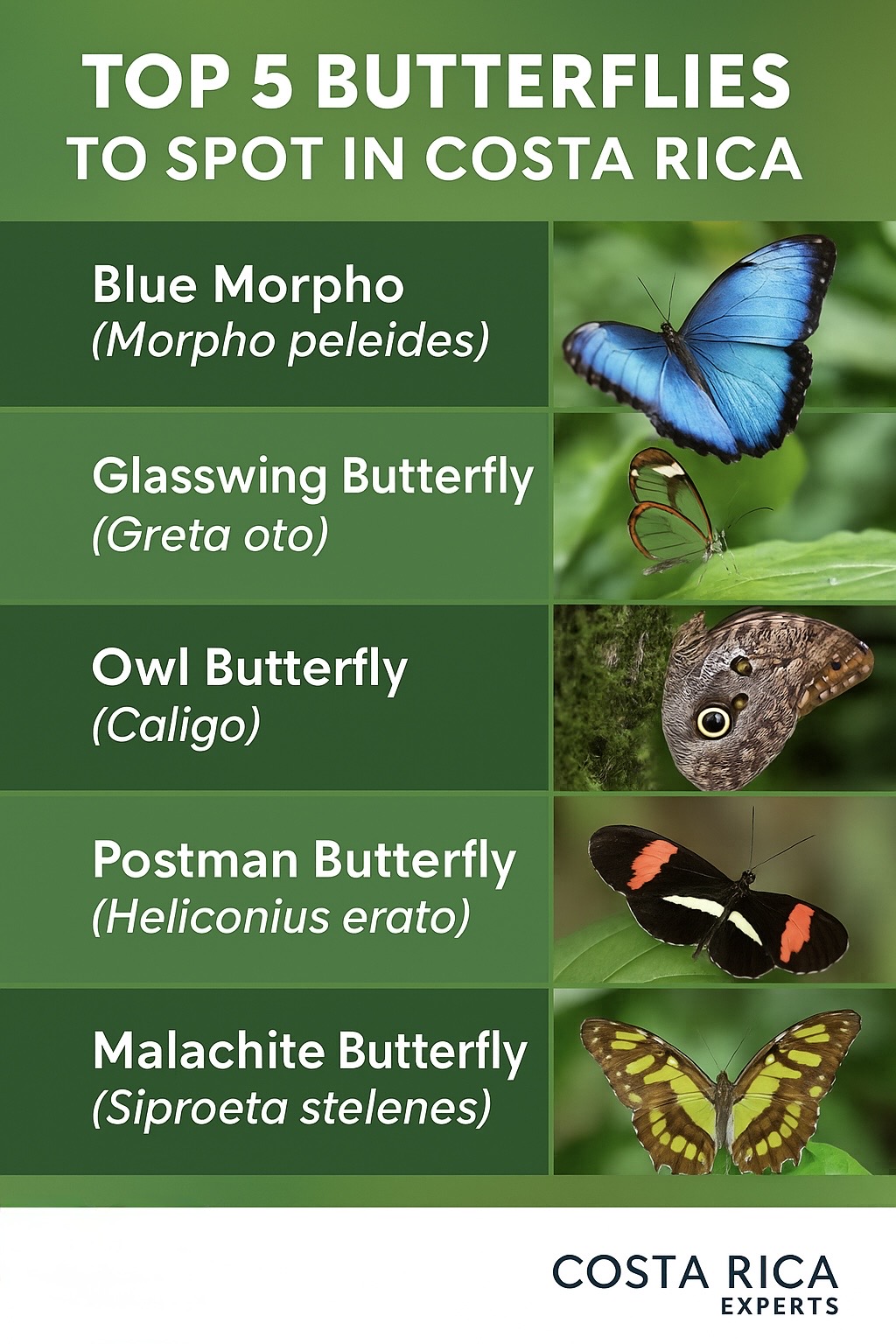
Best Times
- Butterflies are most active during the sunny mornings after rain when they bask and feed.
- Year-round sightings are possible, but wet season (May–November) brings lush vegetation and more activity.
Expert Tips
- Look near sunny forest clearings, flowering plants, and riverbanks.
- Wear bright colors—butterflies are curious and may land on you.
- Visit a butterfly conservatory or garden for guaranteed close-up encounters.
- Bring a macro lens or good zoom if you want to photograph them—Blue Morphos are fast flyers!
Sloths of Costa Rica
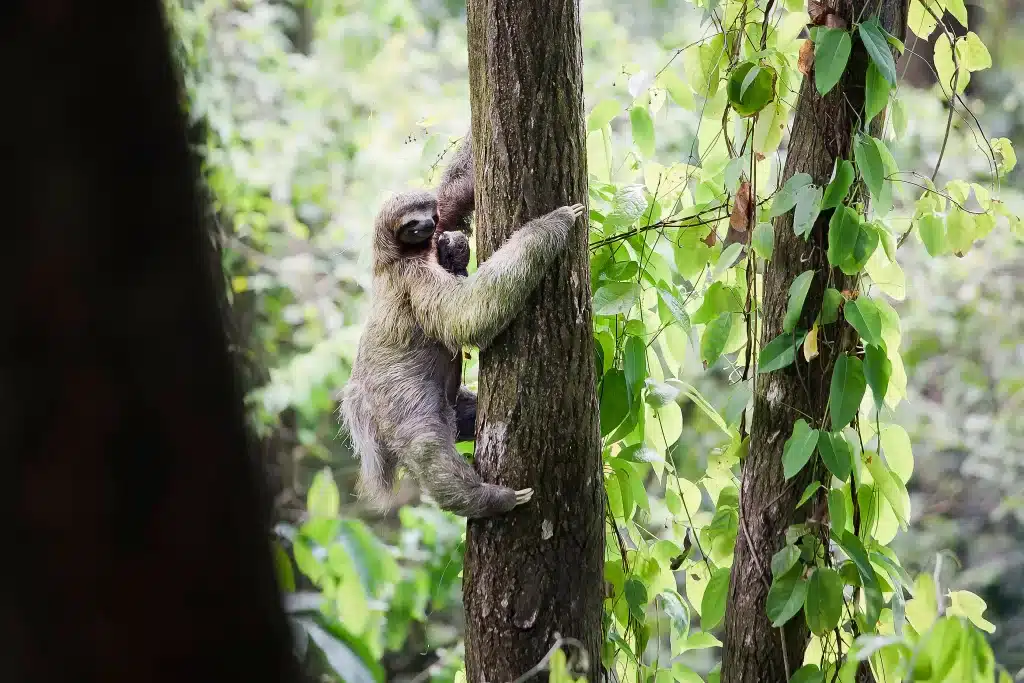
How could we forget the sloth? These gentle, slow-moving creatures are a highlight on nearly every wildlife enthusiast’s bucket list. Costa Rica is home to two species: the two-toed sloth and the three-toed sloth. You’re more likely to spot the three-toed sloth during the day, as they are diurnal and spend time lazily hanging in the treetops. The two-toed sloth, however, is nocturnal—making them trickier to find unless you join a guided night hike, where the sound of rustling leaves in the canopy often gives them away.
Where to See Sloths in Costa Rica
- Manuel Antonio National Park – A top spot with regular sightings along easy trails.
- Tortuguero National Park – Sloths are often seen resting in riverside trees.
- Monteverde Cloud Forest – Higher-altitude sightings, especially three-toed sloths.
- Puerto Viejo & Cahuita (Caribbean Coast) – Excellent areas for both species, with a strong chance of seeing two-toed sloths at night.
- Arenal & La Fortuna – Local reserves and hanging bridge trails are sloth hotspots.
Expert Tips for Spotting Sloths
- Night Tours for Two-Toed Sloths: Book an evening hike in regions like Cahuita or Arenal to increase your chances.
- Hire a Naturalist Guide: Their trained eyes can spot sloths you’d easily miss.
- Look for Movement in the Canopy: A slow turn of the head or rustling leaves may reveal a sloth.
- Bring Binoculars: Sloths are usually high up in the trees.
- Be Patient: Sloths live up to their name—they move very little, but that makes them easier to observe once spotted.
Related Articles:
Toucans
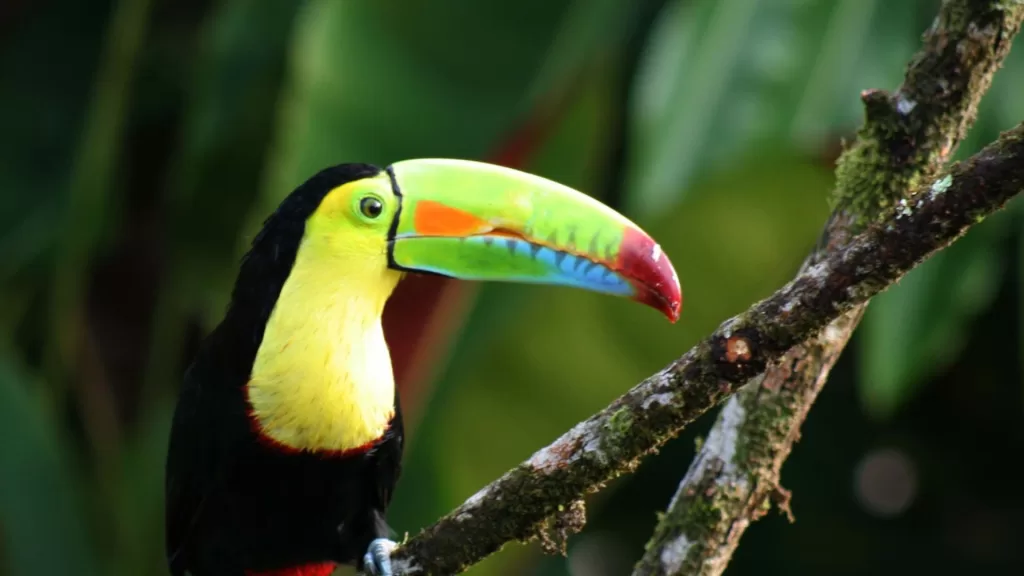
Who hasn’t dreamed of seeing a toucan in the wild? For many of us, Toucan Sam sparked that fascination early on, and Costa Rica is one of the best places on Earth to make it a reality. The country is home to six toucan species, with the most iconic being the Keel-Billed Toucan and the Chestnut-Mandibled Toucan (also called the Yellow-Throated Toucan).
The Keel-Billed Toucan is instantly recognizable thanks to its bright yellow chest and multicolored bill streaked with green, blue, orange, and red. The Chestnut-Mandibled Toucan, on the other hand, has a striking bill of deep red and vibrant yellow, making it equally impressive. Despite their cartoon-like appearance, toucans are frugivorous, feeding primarily on fruit (and definitely not Froot Loops!).
Where to See Toucans in Costa Rica
- Caribbean Lowlands (Tortuguero, Sarapiquí, Puerto Viejo) – Excellent for Keel-Billed Toucans.
- Arenal & La Fortuna – Toucans are frequently spotted in forest reserves and on lodge grounds.
- Monteverde Cloud Forest – Chestnut-Mandibled Toucans are commonly seen here.
- Manuel Antonio National Park – Both species can often be spotted along trails and near the coastline.
- Osa Peninsula & Corcovado – One of the best regions for diverse birdlife, including multiple toucan species.
Expert Tips for Spotting Toucans
- Early Morning & Late Afternoon: Toucans are most active during cooler hours when they forage for fruit.
- Listen for Their Call: Keel-Billed Toucans sound like frogs croaking, while Chestnut-Mandibled Toucans make a loud yelping call.
- Bring Binoculars: Toucans often perch high in the canopy, though they may come lower when feeding.
- Stay Near Fruit Trees: Toucans love wild figs and other tropical fruits. Keep an eye on fruiting trees along trails.
- Guided Birding Tours: Local guides are experts at spotting toucans quickly—especially in dense forest.
Wildcats

Okay, so the Wildcats of Costa Rica are not exactly on the must-see list. You would be lucky if you saw an endangered wildcat in its native habitat. They primarily live in Corcovado National Park, but can sometimes be seen in wildlife rescue sanctuaries.
Costa Rica is home to six species of wildcats, though they are elusive and rarely seen due to their shy, nocturnal nature:
- Jaguar – Largest in Costa Rica, found deep in the primary rainforest.
- Puma (Mountain Lion) – Ranges across the country, adaptable to many habitats.
- Ocelot – Medium-sized, beautifully spotted, active at night.
- Margay – Smaller and tree-dwelling, excellent climber.
- Oncilla (Tigrillo) – Tiny, secretive, prefers highlands.
- Jaguarundi – Sleek, weasel-like cat, more diurnal than others.
Where to See Them
- Corcovado National Park (Osa Peninsula): Best chance to encounter jaguars, pumas, ocelots, and margays in the wild.
- Santa Rosa National Park (Guanacaste): Known for puma sightings.
- Monteverde Cloud Forest & Talamanca Highlands: Habitat for margays and oncillas.
- La Amistad International Park: Remote area with strong populations of multiple species.
- Private Reserves (like Curi-Cancha, Caño Negro): Sometimes offer rare glimpses.
Expert Tips
- Go with a guide: Trained naturalists know signs like tracks, scat, or alarm calls from monkeys and birds.
- Best time: Dawn, dusk, and nighttime hikes increase your odds—most cats are nocturnal or crepuscular.
- Patience & silence: Remain quiet and move slowly; wildcats avoid human noise.
- Look for prey: If you see peccaries, deer, or agoutis, a predator may be nearby.
- Camera traps: Some lodges set up camera traps—ask if they share recent footage with guests.
Reality Check: Spotting a wildcat in Costa Rica is very rare, even for locals and guides. Think of it as a bonus rather than an expectation. However, knowing they roam the forests adds excitement and wonder to any hike!
From the smallest tree frog to the mightiest jaguar, Costa Rica’s wildlife never fails to amaze. Every encounter is a reminder that here, nature doesn’t just surround you—it welcomes you in.
Browse our Nature Vacations for trips that include the best places to spot wildlife!
Related Articles:
Costa Rica Animal FAQs:
What is Costa Rica’s national animal?
The white-tailed deer.
How many animal species are in Costa Rica?
There are about 500,000 animal species in Costa Rica, of which about 300,000 are insects.
Where are the best places to see wildlife in Costa Rica?
The best places to see wildlife in Costa Rica include Corcovado National Park, Marino Ballena National Park, Monteverde Cloud Forest, Manuel Antonio National Park, Tortuguero National Park, and the Southern Caribbean Coast.

















